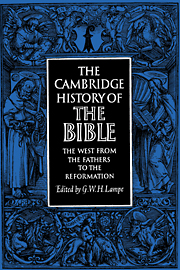Book contents
- Frontmatter
- I The Old Testament: Manuscripts, Text and Versions
- II The History of the Text and Canon of the New Testament to Jerome
- III Early Christian Book-Production: Papyri and Manuscripts
- IV Jerome
- V The Medieval History of the Latin Vulgate
- VI The Exposition and Exegesis of Scripture
- VII The ‘People's Bible’: Artists and Commentators
- VIII Bible Illustration in Medieval Manuscripts
- IX The Vernacular Scriptures
- X Erasmus in Relation to the Medieval Biblical Tradition
- Bibliography
- Notes on the Plates
- Index
- References
I - The Old Testament: Manuscripts, Text and Versions
Published online by Cambridge University Press: 28 March 2008
- Frontmatter
- I The Old Testament: Manuscripts, Text and Versions
- II The History of the Text and Canon of the New Testament to Jerome
- III Early Christian Book-Production: Papyri and Manuscripts
- IV Jerome
- V The Medieval History of the Latin Vulgate
- VI The Exposition and Exegesis of Scripture
- VII The ‘People's Bible’: Artists and Commentators
- VIII Bible Illustration in Medieval Manuscripts
- IX The Vernacular Scriptures
- X Erasmus in Relation to the Medieval Biblical Tradition
- Bibliography
- Notes on the Plates
- Index
- References
Summary
The Old Testament textualist is today more concerned with the story of the textual transmission up to the middle ages than ever before. It is from its manuscripts that he derives both the text itself and the variants for his apparatus criticus, and his interpretation of the medieval transmission controls, to a large extent, his choice of readings. Consequently, the relevance of the present survey of the medieval transmission lies not so much in providing information about textual activities but in an appraisal of their use in the contemporary textual situation. The topic as a whole falls into two fairly exclusive sections, namely the Hebrew (Massoretic) text, and the Versions.
THE HEBREW (MASSORETIC) TEXT
The traditional view of the Hebrew transmission was that the textual minutiae of the Law as the most significant part of the Scriptures were fixed for all time under the influence of Rabbi Aqiba (c. A.D. 55–137), and the standardization of the remainder followed soon afterwards, to produce the official Massoretic text. From that time onward all manuscripts were scrupulously transcribed according to the archetype, and scrutinized by official scribes, so that a correct transmission was assured. Rabbinic evidence, it was said, supported this reconstruction.
On four occasions in rabbinic writings we are told, with a few variations, that three scrolls of the Law, with minor textual divergences, were deposited in the Temple court, and in each case of divergence it was ruled that the majority reading was authoritative. The fact that the legend is set in the Temple area shows that discussion about text standardization goes back at least to the time before A.D. 70, the date of the sack of Jerusalem.
- Type
- Chapter
- Information
- The Cambridge History of the Bible , pp. 1 - 26Publisher: Cambridge University PressPrint publication year: 1969

